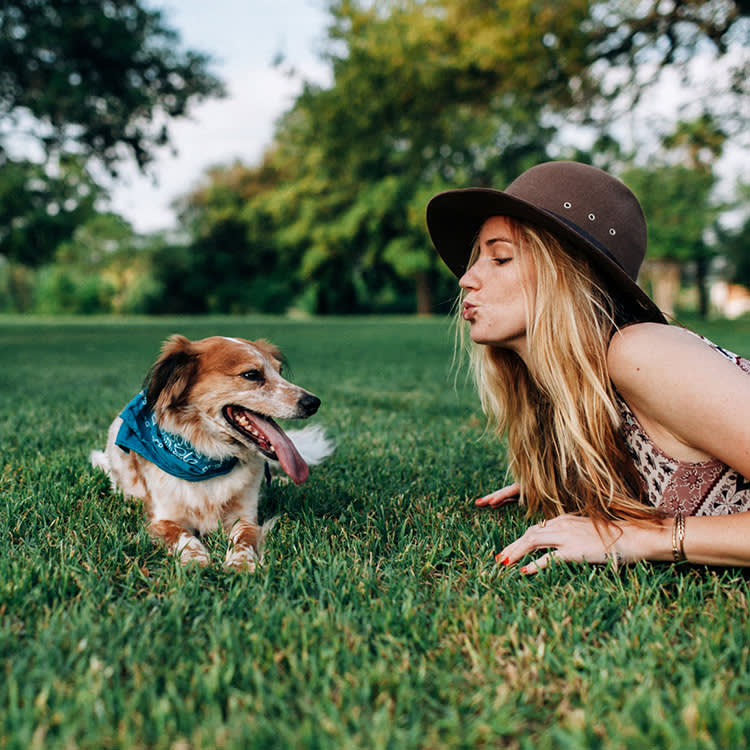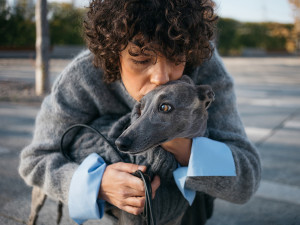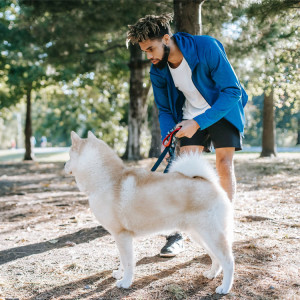Here’s How You Can Avoid the Worst: a Dog Bite to the Face
Step one: never put your face close to theirs

Share Article
As a canine behaviourist, many human behaviours scare me. My heart leaps into my throat when I see people performing risky behaviours, like huggingopens in a new tab and picking up dogs, sticking their faces right by a dog’s face, or bending over a dog. When I see people doing things like this, I want to shout out a warning. I feel the same way when I’m watching a horror movie and want to yell, “Don’t go inside the dilapidated, vine-covered house!”
I work with many clients whose dogs have bitten someone, and as I hear the stories of what happened, the same human behaviours are mentioned over and over. I’m not saying this to blame the people, but rather to help us all learn how to lower our risk of being bitten. Dog bites are a serious problem that should be avoided at all costs. Among the most distressing are bites to the face. In a December 2015 studyopens in a new tab, scientists examined 132 incidents of bites to human faces that did not involve bites to any other parts of the body. The goal of the study was to determine the human behaviour that preceded the bites.

littleKin™ is Kinship’s home just for puppy and kitten parents. Bop over to check out expert advice, new pet tools, and special deals—all curated for your newest family member.
opens in a new tabWell-known risky behaviours, such as bending over a dog, putting your face close to a dog’s face, and making very close eye contact with the dog occurred before many of the bites, which is no surprise. What was a bit of a shock was the percentage of times that these no-no behaviours happened before the 132 incidents in the study.
In 76 percent of the bites, people bent over the dog just before the bite. In 19 percent of cases, a bite was preceded by people putting their faces close to the dog’s face, and in five percent of cases, gazing between dog and person at close range occurred before a bite. In no incidents was a bite to the face preceded by trimming the dog’s nailsopens in a new tab, falling on the dog, hitting the dog as punishment, stepping on the dog, pulling the dog’s hair, tugging the dog’s body or scolding the dog.
More than 75 percent of the bites to the face happened to people who knew the dog. Over two-thirds of the bites were to children, and of those, 84 percent were to children under the age of 12. Children who were bitten were with their parents in 43 percent of the cases and with the dog guardian in 62 percent of the incidents. Sixty percent of the bites were to females, and no adults were bitten by their own dogs. More than half of the bites were to the nose and lips of the person, as opposed to the chin, cheek, forehead or eye area.
All of the dogs who bit someone in the face were adult dogs, and over two-thirds of them were male. In only six percent of the bites did people report that the dog gave a warning such as growling or performing a tooth display (aka, showing their teeth) prior to biting. To me, this is the single most surprising finding in the study, and I think it’s quite possible that some people didn’t notice or failed to remember warnings from the dogs.
As the authors of the paper mention, their research is based on questionnaires that asked people about past events. As a result, there are inherent limitations to the study. Still, the findings about the frequency with which kids are bitten, the greater likelihood of male dogs biting faces than female dogs, and the finding that only adult dogs bite faces are consistent with previous research – and they show that our human actions often have a role in a snappy pup’s behaviour.

Karen B. London, PhD, CAAB, CPDT-KA
Karen B. London, Ph.D., is a Certified Applied Animal Behaviorist and Certified Professional Dog Trainer who specializes in working with dogs with serious behavioral issues, including aggression, and has also trained other animals including cats, birds, snakes, and insects. She writes the animal column for the Arizona Daily Sun and is an Adjunct Professor in the Department of Biological Sciences at Northern Arizona University. She is the author of six books about training and behavior, including her most recent, Treat Everyone Like a Dog: How a Dog Trainer’s World View Can Improve Your Lifeopens in a new tab.
Related articles
![Shy black dog walking with owner at the park.]() opens in a new tab
opens in a new tabHow to Help an Anxious Dog Conquer Their Fears
Six animal behaviourists share pro tips for boosting the confidence of a fearful dog
![man unleashing dog in a park]() opens in a new tab
opens in a new tab6 Steps to Improve Your Dog’s Recall Training
Teach your pup a perfect recall so you can be sure they will come back, no matter what
![Dog hiding under the sofa and afraid to go out because he heard fireworks.]() opens in a new tab
opens in a new tabWhy Are Dogs Scared of Fireworks?
How to keep your dog mentally and physically safe this Bonfire Night
![Dog chewing spiked orange toy at home]() opens in a new tab
opens in a new tab6 Ways to Keep Your Dog Entertained While You’re At Work
Don’t hit pause on your pet’s playtime – these solo activities will help 9–5 fly by for them





